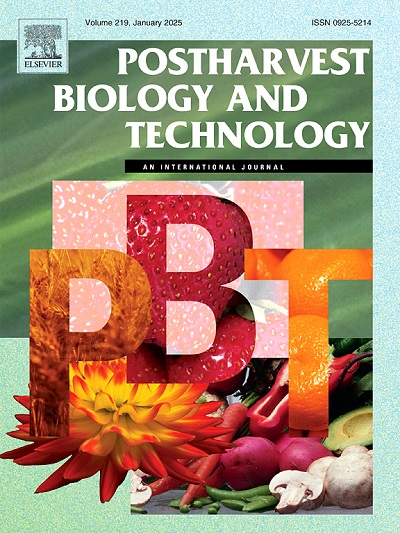吲哚-3-乙酰胺是2,4-二氯苯氧乙酸在柑橘采后处理中的有效替代品
IF 6.8
1区 农林科学
Q1 AGRONOMY
引用次数: 0
摘要
合成生长素2,4-二氯苯氧乙酸(2,4- d)已被广泛应用于柑橘采后处理,以保持果实的新鲜度。然而,由于欧洲联盟和几个亚洲国家对其使用的限制,有必要开发一种有效的替代品。本研究探讨了吲哚-3-乙酰胺(IAM)在植物组织中酶促转化为活性生长素的生长素前体在减缓花萼衰老和保持果实品质方面的潜力。贮藏28 d后,IAM处理和2,4- d处理的果实花萼衰老率分别为44 %和48 %,均低于对照(65 %)。IAM处理有效地减少了采后水分流失,而不影响总可溶性固体(TSS)和可滴定酸度(TA)含量。活性氧(ROS)分析揭示了IAM对O2•-和H2O2水平的影响。值得一提的是,IAM显著提高了贮藏前期总酚和类黄酮的积累,促进了贮藏后期木质素的生物合成。此外,与对照相比,经iam处理的果实显示出脯氨酸、天冬酰胺、苏氨酸、苯丙氨酸和蔗糖等关键初级代谢物水平的升高。在纽霍尔脐橙和奥林达瓦伦西亚橙中进一步验证了IAM延缓花萼衰老的功效,强调了其作为柑橘采后管理中2,4- d的可行替代品的潜力。本文章由计算机程序翻译,如有差异,请以英文原文为准。
Indole-3-acetamide is an efficient alternative to 2,4-dichlorophenoxyacetic acid in citrus postharvest handling
The synthetic auxin 2,4-dichlorophenoxyacetic acid (2,4-D) has been extensively applied in citrus postharvest treatment for over six decades to preserve fruit freshness. However, restrictions on its use in the European Union and several Asian countries have necessitated the development of an effective alternative. This study explores the potential of indole-3-acetamide (IAM), an auxin precursor enzymatically converted to active auxin within plant tissues, in mitigating calyx senescence and preserving fruit quality in Satsuma mandarin. After 28 d of storage, calyx senescence rates in IAM and 2,4-D treated fruit were 44 % and 48 %, respectively, both lower than that of the control (65 %). IAM treatment effectively minimized postharvest water loss without compromising total soluble solids (TSS) and titratable acidity (TA) content. Reactive oxygen species (ROS) analysis revealed contrasting effects of IAM on O2•- and H2O2 levels. Notably, IAM markedly enhanced total phenolic and flavonoid accumulation during the early storage phase and promoted lignin biosynthesis in the later stage. Additionally, IAM-treated fruit exhibited elevated levels of key primary metabolites, including proline, asparagine, threonine, phenylalanine, and sucrose, compared to the control. The efficacy of IAM in delaying calyx senescence was further validated in Newhall navel orange and Olinda Valencia orange, underscoring its potential as a viable alternative to 2,4-D in citrus postharvest management.
求助全文
通过发布文献求助,成功后即可免费获取论文全文。
去求助
来源期刊

Postharvest Biology and Technology
农林科学-农艺学
CiteScore
12.00
自引率
11.40%
发文量
309
审稿时长
38 days
期刊介绍:
The journal is devoted exclusively to the publication of original papers, review articles and frontiers articles on biological and technological postharvest research. This includes the areas of postharvest storage, treatments and underpinning mechanisms, quality evaluation, packaging, handling and distribution of fresh horticultural crops including fruit, vegetables, flowers and nuts, but excluding grains, seeds and forages.
Papers reporting novel insights from fundamental and interdisciplinary research will be particularly encouraged. These disciplines include systems biology, bioinformatics, entomology, plant physiology, plant pathology, (bio)chemistry, engineering, modelling, and technologies for nondestructive testing.
Manuscripts on fresh food crops that will be further processed after postharvest storage, or on food processes beyond refrigeration, packaging and minimal processing will not be considered.
 求助内容:
求助内容: 应助结果提醒方式:
应助结果提醒方式:


